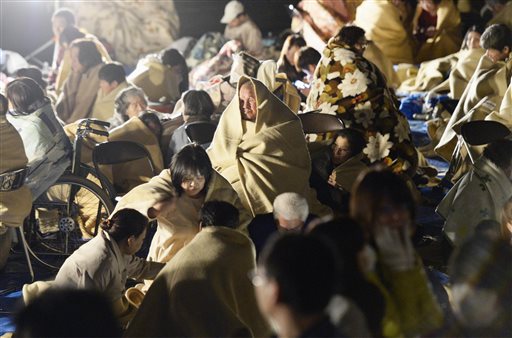- California Assembly OKs highest minimum wage in nation
- S. Korea unveils first graphic cigarette warnings
- US joins with South Korea, Japan in bid to deter North Korea
- LPGA golfer Chun In-gee finally back in action
- S. Korea won’t be top seed in final World Cup qualification round
- US men’s soccer misses 2nd straight Olympics
- US back on track in qualifying with 4-0 win over Guatemala
- High-intensity workout injuries spawn cottage industry
- CDC expands range of Zika mosquitoes into parts of Northeast
- Who knew? ‘The Walking Dead’ is helping families connect
Strong quake kills 9, injures more than 760 in Japan

Residents wrap themselves in blankets as they take shelter outside the town hall of Mashiki, near Kumamoto city, southern Japan, after the earthquake early Friday, April 15, 2016.
TOKYO (AP) — At least nine people were killed and 761 injured by a magnitude-6.5 earthquake Thursday night that knocked down houses and buckled roads in southern Japan, the government’s chief spokesman said.
Yoshihide Suga said he would visit the area Friday to assess the damage. He said some 1,600 soldiers had been deployed, and TV reports showed some delivering blankets and adult diapers to the thousands of people who took shelter because their homes were wrecked or unsafe.
The worst damage was in the town of Mashiki, about 15 kilometers (9 miles) east of Kumamoto city on the island of Kyushu, said Kumamoto prefecture disaster management official Takayuki Matsushita.
The area is about 1,300 kilometers (800 miles) southwest of Tokyo.
Suga said 44 of those injured were seriously hurt.
The quake struck at 9:26 p.m. at a depth of 11 kilometers (7 miles) near Kumamoto city on the island of Kyushu, the Japan Meteorological Agency said. There was no tsunami risk.
“The shaking was so violent I couldn’t stand still,” said Hironobu Kosaki, a Kumamoto Prefectural Police night-duty official.
Suga said at least 19 houses collapsed, and hundreds of calls came in reporting building damage and people buried under debris or trapped inside.
The extent of the damage was becoming more clear with daybreak.
Rescue operations were repeatedly disrupted by aftershocks.
“There was a ka-boom and the whole house shook violently sideways,” Takahiko Morita, a Mashiki resident said in a telephone interview with Japanese broadcaster NHK. “Furniture and bookshelves fell down, and books were all over the floor.”
Morita said some houses and walls collapsed in his neighborhood, and water supply had been cut off.
Local broadcasters were urging residents who could to check on elderly people living alone who might not be able to escape their homes unaided.
Dozens of people evacuated their homes and gathered outside Mashiki town hall, sitting on tarps well after midnight. Some wrapped blankets around their shoulders against the springtime chill.
Suga said there no abnormalities at nearby nuclear facilities. The epicenter was 120 kilometers (74 miles) northeast of Kyushu Electric Power Co.’s Sendai nuclear plant, the only one operating in the country.
Most of Japan’s nuclear reactors remain offline following the meltdowns at the Tokyo Electric Power Co.’s Fukushima plant in 2011 after a magnitude-9.0 earthquake triggered a huge tsunami.
Television footage showed fires breaking out in some places, with firefighters battling an orange blaze.
Keisukei Urata, an official in nearby Uki city who was driving home when the quake struck, told NHK that parts of the ceiling at Uki City Hall collapsed, windows broke and cabinets fell to the ground.
Kasumi Nakamura, an official in the village of Nishihara, said that the rattling started modestly and grew violent, lasting about 30 seconds.
“Papers, files, flower vases and everything fell on the floor,” he told NHK.
There were multiple aftershocks, the largest one with a preliminary magnitude of 6.4 shortly after midnight, according to the Japan Meteorological Agency.
The U.S. Geological Survey measured the initial quake’s preliminary magnitude at 6.2. It upgraded its damage assessment to red, meaning extensive damage is probable and the disaster likely widespread.
Footage from an NHK bureau in the area showed books, files and papers raining down to the floor. One employee appeared to have fallen off a chair, while others slid under their desks to protect their heads.











![그룹 방탄소년단(BTS) [BTS 공식 트위터. 재판매 및 DB 금지]](http://www.koreatimesus.com/wp-content/uploads/2025/07/Untitled-5-copy-199x223.jpg)




